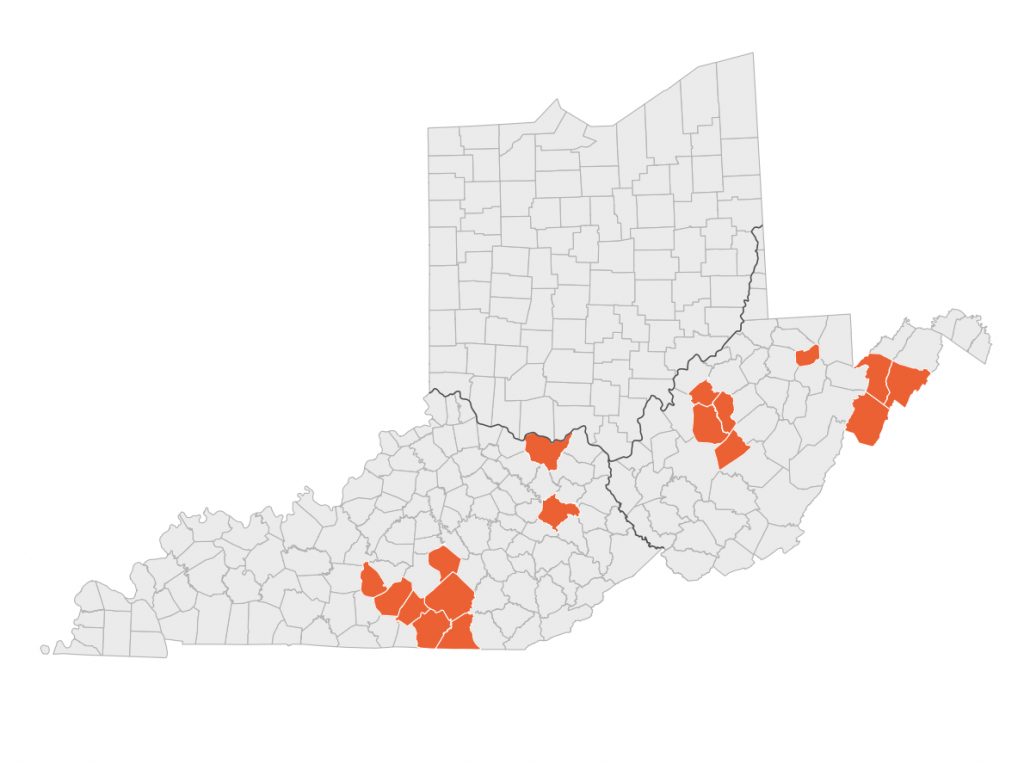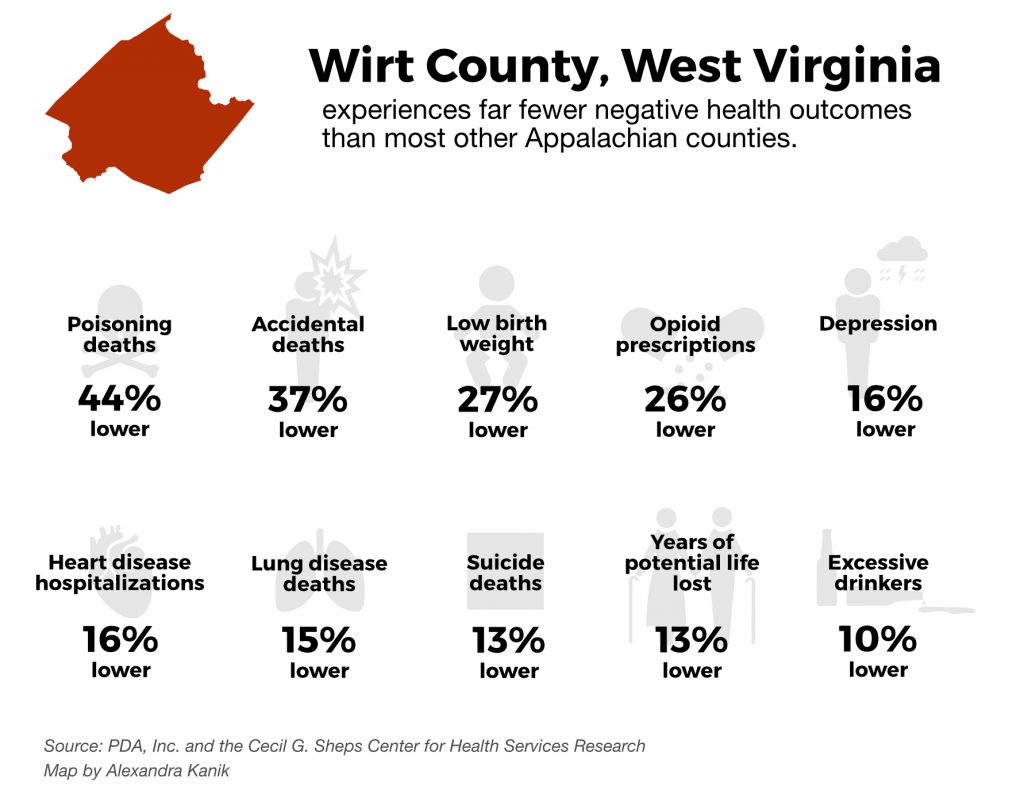News
Bright Spots: Positive Outliers In A Region Plagued By Poor Health
By: Aaron Payne | Ohio Valley ReSource
Posted on:
By most measures, health outcomes in the Ohio Valley region are not very good, with many parts of Kentucky, Ohio, and West Virginia ranking near the bottom among states.
But a team of health researchers may have found a few places within the region that stand out. They see them as potential ‘bright spots’ — places with some health measures better than expected for the region.
Now the researchers want to know why these communities fare better and whether the lessons can be applied elsewhere.
The Search For Bright Spots
Residents of West Virginia’s smallest county give different answers when asked to describe their home.
“There is here a very strong sense of community,” a local reverend said.
“The people are friendly. They’re helpful,” according to a woman working with a local non-profit operating in one of the county’s poorest areas.
And the county’s new school’s nurse said “It’s tiny, it’s rural. I mean, we don’t even have a stoplight.”
Wirt County might lack a stoplight but some organizations interested in Appalachian health are looking into whether it might be a “Bright Spot.”
Two years ago the Robert Wood Johnson Foundation, the Appalachian Regional Commission, and the Foundation for a Healthy Kentucky launched a project called “Creating a Culture of Health in Appalachia: Disparities and Bright Spots.”
The first step in the ongoing project was to collect available data on how Appalachia is affected by certain public health issues.

“The second part is to see where folks are performing better than expected, based on these indicators,” ARC Communications Director Wendy Wasserman said.
Wirt appears to score better in categories including rates of depression, and deaths due to injuries or poisoning.
The next phase of the project requires field teams to visit each county and investigate if the Bright Spot designation holds up with data collected from the source.
Safe on the Farm
Researchers meeting with health and community leaders in Wirt County are interested in programs that could contribute to positive outcomes.
Injury mortality, for example, was one of the best categories for the area.
West Virginia University Extension Service offered a program in the county aimed at keeping children who work on family farms safe from injury.
Investigators working on the Youth Safe Farm initiative would visit these sites and teach both children and parents how to identify dangers on the farm, according to the Associate Dean of Programming and Research Cindy Fitch.
“They were even able to go to the farms and identify and mitigate some of the hazards,” Fitch said.
The families could develop their own plan to follow safety precautions and could receive a special Youth Safe Farm designation as they followed through.

Fitch said she believes the young farmers will continue practicing safety for years to come thanks to the grant-funded program.
WVU Extension Service offers other programs in the county administered by an agent stationed locally. The initiatives branch out from Agriculture and include healthy eating classes, youth development, and workforce development.
While they offer many of the same programs throughout West Virginia’s 55 counties, county agents will tweak them to better suit their residents, according to Fitch.
“The agents have a great deal of flexibility to tailor programs in a way to address the needs of their county as long as they keep the basic components that make that program effective.”
Shopping for Hope
The Bright Spots researchers are also interested in programs or organizations that may not be traditionally thought of as related to health, but contribute to community pride and social connections.
Talk to Wirt County residents about what makes their community and it won’t be long before someone mentions The Hope Shop.
The shop’s primary function is a food pantry, providing non-perishable food items, produce, and frozen meat to around 60 families in need per month.
“When they go out of here they have a lot of groceries,” Elise Sheppard, a Hope Shop volunteer and former interim manager said.
The all-volunteer staff — under the supervision of a group of churches in the town called the Wirt Ministerial Alliance– organize the stock of donations from the community and purchased food from regional food banks to distribute.

Community donations and grants help with the non-profit’s finances. But the Hope Shop thrift shop is also a valuable asset to the operation.
“And that’s because we’re selling clothes, all kinds of things. And we keep our prices very low. It’s interesting that everyone shops at the Hope Shop,” Sheppard said.
The store has operated under different models since it was founded around two decades ago. And it hasn’t always been as financially stable as it is now.
Rev. Lee Williams, the chair of the Ministerial Alliance, remembers a time when they were in need of money to pay the bills at the shop. Some of the women who attended his church decided to hold a benefit dinner.
“They were able to raise over $1,000 in a day,” he said. “People know the reputation of the ladies here and their cooking. But it’s also the value that people had in the Hope Shop and the work that it does.”
Nearly every Wirt County resident can tell you a story about how an organization or a person was in need and the community came together to pick them up.
Sheppard has lived in several different places during her life and these stories are what distinguish this community in her mind.
“The thing that amazes me here is that they don’t have a lot of resources, but they take care of each other,” she said.
The Hope Shop has the support of other local organizations. They work with them to meet the needs of the community.
It’s difficult to find an organization in Wirt County that does not work with other local organizations in some way.
The Wirt County Prevention Coalition is perhaps the largest collaborative effort in the county. It combines 12 local and regional organizations with the goal of bringing health resources and education to the county.
The sense of community and collaboration isn’t surprising. The latest County Health Rankings found social associations in Wirt County were 10.2 per 10,000 people in 2013, compared to the 9.2 average for the rest of the U.S.
Accepting a Challenge
Even if it is designated a bright spot, Wirt County still has its challenges with available resources and health problems.
While local organizations and medical professions do a lot for the community, there could be more to meet the demand. And while nearby counties offer those services, transportation from Wirt County is a challenge for many people.
 Alexandra Kanik | Ohio Valley ReSource
Alexandra Kanik | Ohio Valley ReSourceMeanwhile, Wirt County did not exceed expectations in every health outcome the research team analyzed.
Statistics show residents struggle with obesity and don’t get as much physical activity as they should.
But an organization that operates throughout the region has filled a unique role in Wirt County in encouraging people to get active.
Temple Challenge is a faith-based fitness program founded by a West Virginia native who wanted to share her testimony and spread fitness opportunities to areas in need at an affordable rate.
In Wirt County, classes are held twice a week in the Elizabeth Baptist Church Community Building.
Students will come in a little early to help move most of the tables and chairs out of the way and run around those left out.
Kim Poling, an accountant by trade, has been leading the sessions as of late. She went through the program herself and started leading sessions in a nearby county when she came to fill in for another trainer.
She likes the program because anyone can participate.
“It’s something that can be modified for anybody of any age. You can do as much or as little as you need to and every class is different,” she said. “But it’s just about physically trying to take care of your body.”
In other counties it serves, Temple Challenge is just one more fitness option alongside gyms and recreation facilities. But for some of the students in Wirt County, it’s their only opportunity.
Melanie Corbitt and Kim Richards are both participants in the program. They say it’s their best chance to access this type of exercise.
“We don’t actually have a convenient place to go to work out with workout machines or anything like that,” Corbitt said.
“The only one that has it is Senior Citizens Center and at 4 o’clock, they shut down,” Richards adds.
The Senior Center offers their exercise facility to the public for a small fee, but those who work in the evenings can’t get there in time.
Local schools are available to the public as well, if they can acquire permission and a key.
Wait and See
With research still in the works, the project’s sponsors are not sure what they will learn.
And the project is far from completion. Hopeful estimates anticipate researchers having more concrete information early next year.
But if Wirt County is a Bright Spot, the hope is that learning what works there can be shared elsewhere and provide Appalachia a little more light.

